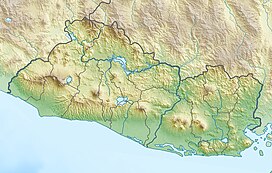Lake Ilopango is a crater lake which fills an 8 by 11 km: 70.5 km2 (27.2 sq mi) volcanic caldera in central El Salvador, on the borders of the San Salvador, La Paz, and Cuscatlán departments.[5] The caldera, which contains the second largest lake in the country and is immediately east of the capital city, San Salvador, has a scalloped 100 m (330 ft) to 500 m (1,600 ft) high rim.[6] Any surplus drains via the Jiboa River to the Pacific Ocean. The local military airbase, Ilopango International Airport, has annual airshows where international pilots from all over the world fly over San Salvador City and Ilopango lake.
| Lake Ilopango | |
|---|---|
 Westward view from lake Ilopango, aft San Salvador Metropolitan Area and San Salvador (volcano) lie just ahead | |
| Highest point | |
| Elevation | 450 m (1,480 ft) |
| Coordinates | 13°40′N 89°03′W / 13.67°N 89.05°W |
| Geography | |
| Location | El Salvador |
| Geology | |
| Mountain type | Caldera |
| Last eruption | 1879 to 1880 |
| Lake Ilopango | |
|---|---|
 Eastward view from San Salvador (volcano), San Salvador Metropolitan Area at the center and aft, the ilopango caldera lies just behind along with San Vicente (volcano) | |
| Location | Central El Salvador |
| Coordinates | 13°40′N 89°03′W / 13.67°N 89.05°W |
| Type | crater lake |
| Basin countries | El Salvador |
| Max. length | 11 km (6.8 mi) |
| Max. width | 8 km (5.0 mi) |
| Surface area | 70.5 km2 (27.2 sq mi)[1] |
| Average depth | ~ 170 m (560 ft)[2] |
| Max. depth | 231 m (758 ft)[3] |
| Water volume | ~ 12 km3 (2.9 cu mi)[4] |
| Surface elevation | 440 m (1,440 ft) |
| Islands | Islas Quemadas |
Eruptive history
editFour major dacitic–rhyolitic eruptions occurred during the late Pleistocene and Holocene, producing pyroclastic flows and tephra that blanketed much of the country.
The caldera collapsed most recently[6] sometime between 410 and 535 CE (based on radiocarbon dating of plant life directly related to the eruption),[7] which produced widespread pyroclastic flows and devastated Mayan cities; however, a team of scientists concluded that the volcanic eruption might have happened in 431±2 CE, based on volcanic shards taken from ice cores in Greenland, levels of sulphur recorded in ice cores from Antarctica, and radiocarbon dating of a charred tree found in volcanic ash deposits.[8] The eruption is estimated to have produced around 37–82 km3 (8.9–19.7 cu mi) of ejecta (DRE—several times more than the 1980 eruption of Mount St. Helens),[9] which puts it at a rating of 6 on the Volcanic Explosivity Index (VEI) and makes it one of the biggest volcanic events on Earth in the last 7,000 years.[10] Fallout from the eruption column blanketed an area of at least 10,000 km2 (3,900 sq mi) with pumice and ash to a depth of at least 50 cm (20 in),[7] and an area of nearly 2,000,000 km2 (770,000 sq mi) to a depth of at least 0.5 cm (0.20 in),[8] which would have stopped all agricultural production in the most-severely affected area for decades. It is also theorized that the eruption and subsequent weather events and agricultural failures directly led to the abandonment of Teotihuacan by the original inhabitants.[8][11]
It was hypothesized that this eruption caused the extreme weather events of 535–536 in Europe and Asia, but this is unlikely given the research published in 2020 that dates the eruption to 431 CE.[8]
Later eruptions formed several lava domes within the lake and near its shore. The only historical eruption, which occurred from December 31, 1879, up to March 26, 1880, produced a lava dome and had a VEI of 3.[6] The lava dome reached the surface of the lake, forming the islets known as Islas Quemadas.[12][13]
Events
editOn July 5, 2004 the illusionist, Francis Fanci was tagged and submerged inside a trunk from which he emerged after thirty seconds. On the other hand, in 2004 Matthew Hatfield Knight, eldest son of the owner of the international consortium of Nike sports shoes, died of a heart attack while diving with his colleagues.
See also
editReferences
edit- ^ Ilopango Lake, on sciencedirect.com
- ^ Ilopango Lake, on sciencedirect.com
- ^ Ilopango Lake, on sciencedirect.com
- ^ Ilopango Lake, on sciencedirect.com
- ^ "Lake Ilopango". Encyclopædia Britannica. Retrieved 13 July 2012.
- ^ a b c "Ilopango: Eruptive History". Global Volcanism Program. Smithsonian Institution.
- ^ a b Dull, Robert A.; Southon, John R.; Sheets, Payson (2001). "Volcanism, Ecology and Culture: A Reassessment of the Volcan Ilopango Tbj eruption in the Southern Maya Realm". Latin American Antiquity. 12 (1). Latin American Antiquity, Vol. 12, No. 1: 25–44. doi:10.2307/971755. JSTOR 971755. S2CID 163686184., esp. p.27.
- ^ a b c d Victoria C. Smith; et al. (2020). "The magnitude and impact of the 431 CE Tierra Blanca Joven eruption of Ilopango, El Salvador". PNAS. 117 (42): 26061–26068. doi:10.1073/pnas.2003008117. PMC 7584997. PMID 32989145.
- ^ Jicha, Brian R; Hernández, Walter (January 2022). "Effusive and explosive eruptive history of the Ilopango caldera complex, El Salvador". Journal of Volcanology and Geothermal Research. 421 (107426). Elsevier. doi:10.1016/j.jvolgeores.2021.107426. Retrieved 2023-12-29.
- ^ Greshko, M. Colossal volcano behind 'mystery' global cooling finally found. National Geographic. 23 August 2019.
- ^ Clive Oppenheimer (2011). Eruptions that shook the world. Cambridge University Press. ISBN 978-0-521-64112-8.
- ^ Golombek, Matthew P.; Carr, Michael J. (1978). "Tidal triggering of seismic and volcanic phenomena during the 1879–1880 eruption of Islas Quemadas volcano in El Salvador, Central America". Journal of Volcanology and Geothermal Research. 3 (3–4): 299–307. Bibcode:1978JVGR....3..299G. doi:10.1016/0377-0273(78)90040-9.
- ^ "Historia y cultura de Ilopango". Elsalvadorenelmundo.com. Archived from the original on 2014-02-04. Retrieved 2014-02-02.

